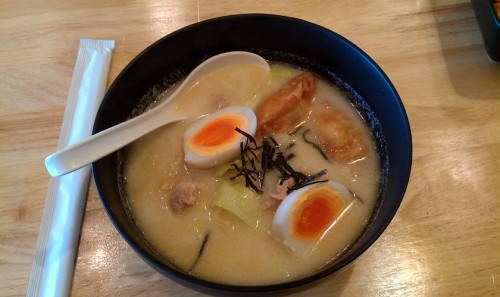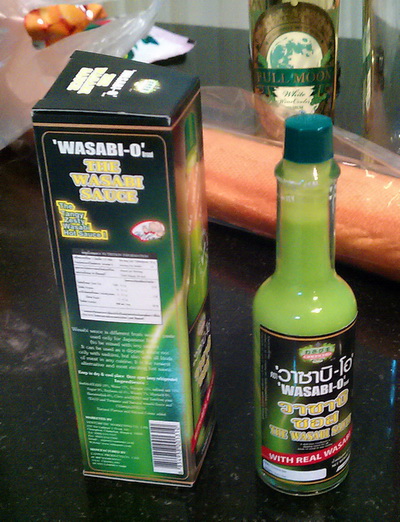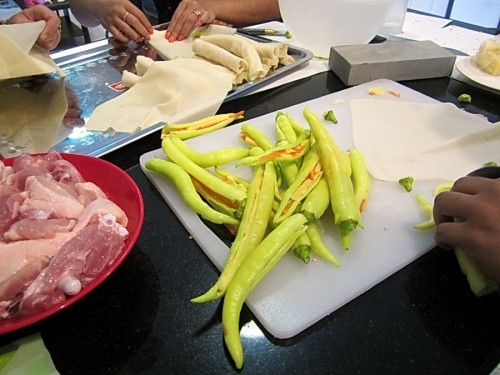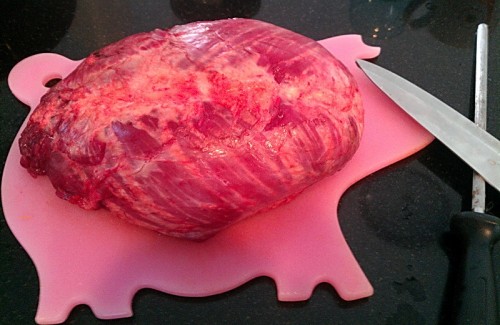Oh, my Gac! Or should I say, fuck cow?
The tree I planted a handful of gac vines under, in a pot, allowed just one enough shade to survive a full year. I’ve only spotted one fruit so far, but I’m looking forward to see if it will fully ripen.
Raising a family in Thailand // Documenting Issan food, culture, music, and people

Oh, my Gac! Or should I say, fuck cow?
The tree I planted a handful of gac vines under, in a pot, allowed just one enough shade to survive a full year. I’ve only spotted one fruit so far, but I’m looking forward to see if it will fully ripen.
Went to a new Japanese restaurant opening today with Tong. It wasn’t crowded at all, and my first impression was bad because it reeked of fresh paint inside.
I don’t want to go into much detail, because we only had a few dishes, but what we did have was enough to lure me back again to try some other things.





Overall, I give this place a 6/10 (so far) – worth going to check out. The food had problems, but hopefully they will be ironed out soon.
Strengths: Reasonably priced (much cheaper than Japanese restaurants in Sermthai Complex). Has at least a couple strong dishes; soup gyoza is pretty good (tried two dishes with it).
Weaknesses: Smells of paint. Bad noodles (unforgivable for Japanese ramen). Bad sushi (not pictured above). Not much parking. Iced green tea is tooth-dissolvingly sweet. Hot tea is cheap and flavorless.
The place is located next to the copy shop on the corner of Highway 208 and Nakorn Sawan Soi 18 (the street that goes down to N&N 2 and Med Side) next to the copy shop.
http://goo.gl/maps/4E53T
Last year, I wrote an e-mail to my Santa Claus impersonating buddy in Japan (impossible to find a link for you, dude – there are at least 7 “Santa Daves” on Facebook and even a “Big Wave Santa”) telling him that they had brought a Tabasco-like wasabi sauce to market: Wasasco. He recently tried to find some, but couldn’t. I remembered that I’d seen something similar at Big-C, so went to check it out.

OK, the most shocking thing about this product is that it is not only edible, it is FUCKING DELICIOUS! Serious noms. It’s like the perfect dip for potato chips, creamy and atomic. I could see doing capfuls of this for losers of drinking games.
The thing is, Big-C had a whole shelf of these bottles on clearance, so I hope the Wasabi-O company isn’t going under or something. Time to go stock up, because the last favorite hot sauce I had here, Wolf, which tasted kind of like Cholula and Tapatio mixed together, just disappeared one day. Although I’d stocked up on half a dozen bottles of that, it didn’t last a year. I’m going to Big-C to buy up their stock, I guess.
——————–
It occurs to me that McDonalds is possibly vindicated from Adam’s online criticism from a decade ago.
A couple of Pinoy exchange students came over to the house last month to make some food, and we had a party with their classmates and some teachers. In order to avoid posting any incriminating evidence, I will limit myself to a single photograph here:

One of these kids was about half my age and played really classic songs on the guitar – it’s unnerving to hear songs from when I was a child played by someone younger than the original artists’ kids (or maybe even grandkids!) – Woodie Guthrie, Kansas, Bread, etc., etc., I want an 8-track player for my Crown now.
Also, the food was really good.
Thanks, Bryllie and Job! Maybe I’ll make it around to the University of Luzon some time..
After years of experimenting with the tough meat of Bos primigenius indicus (commonly known as Brahma or Brahman, the breed of bovine originating in India that eventually spread to the rest of the world to be enslaved, robbed of milk, and mass-consumed – why oh why did they ever leave the land in which they were worshiped?), I have found the best cut of meat for general purposes:


This is what is referred to as the “neck hump,” or more disgustingly, the “neck boil.” Here is a good photo of one, if you can keep your eyes off of dangling distractions:

This cut of meat is not tender enough for steaks, but is great for stews, curries, and the like. I have never had a good beef steak in Thailand, and it is my belief that, generally, the tenderness of beef runs inverse to your current proximity to India, with a few exceptions (Japan being the most notable). That’s fine, since it’s a trade off for good quality of other meats, fish, and fowl.
I used the neck hump above to make an excellent batch of Japanese curry a couple months ago. When we went to buy it from a roadside stand, we were lucky to get it very fresh: